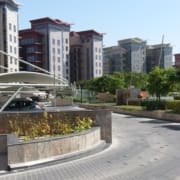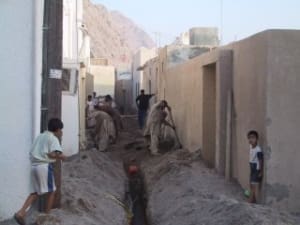The Downside of Saving Water
In recent times severe water shortages in many parts of the world have led Water Authorities and consumers to rethink how water is used in households. Water restrictions in many areas have drastically cut the amount of potable water used, with car washing and garden watering severely restricted. Water savings devices have now been installed in many homes and many more products are now being developed. This is having a big impact on the way wastewater is taken from houses to be treated by municipal authorities.

Many municipalities will soon adopt policies allowing greywater to be re-used within the house or on the garden. Products such as water efficient showerheads, washing machines, and flow inhibitors on taps as well as low flush toilets are reducing how much wastewater is sent to the treatment plant for treatment. Community education programmes are also informing consumers about ways to reduce water use.
Wastewater can be categorised into two components; greywater and blackwater. The main difference between greywater and blackwater is the biological and solids content. Blackwater is essentially the water that has all of the solids in it and cannot come into contact with humans unless treated. Household wastewater can be broken down as follows:-
| Greywater |
{f2ac4d1e1d40dc2e2d9280a1dfa90d854b2d8c80eba743affa37fc4ce2e16def} |
Blackwater |
{f2ac4d1e1d40dc2e2d9280a1dfa90d854b2d8c80eba743affa37fc4ce2e16def} |
| Showers Baths/Spa’s |
33{f2ac4d1e1d40dc2e2d9280a1dfa90d854b2d8c80eba743affa37fc4ce2e16def} |
Toilets |
32{f2ac4d1e1d40dc2e2d9280a1dfa90d854b2d8c80eba743affa37fc4ce2e16def} |
| Basin |
5{f2ac4d1e1d40dc2e2d9280a1dfa90d854b2d8c80eba743affa37fc4ce2e16def} |
Kitchen |
7{f2ac4d1e1d40dc2e2d9280a1dfa90d854b2d8c80eba743affa37fc4ce2e16def} |
| Laundry |
23{f2ac4d1e1d40dc2e2d9280a1dfa90d854b2d8c80eba743affa37fc4ce2e16def} |
|
|
| Total |
61{f2ac4d1e1d40dc2e2d9280a1dfa90d854b2d8c80eba743affa37fc4ce2e16def} |
|
39{f2ac4d1e1d40dc2e2d9280a1dfa90d854b2d8c80eba743affa37fc4ce2e16def} |
In most cities and towns wastewater moves from houses via a gravity reticulation network to the treatment plant, where it is treated to an acceptable level and sent to an ocean outfall or into the ground for further long term treatment or increasingly recycled for use in industry or public areas.
Gravity pipework is laid with sufficient grade (1/60;1/80;1/100) to allow for water to push any solids down the pipe toward a pump station which will bring it back to the surface and then gravitate again to the next pump station, until ultimately it will bring the wastewater to the treatment plant. The pipework will sometimes need to be installed quite deep (5-10 metres) to minimise the number of pump stations required.
The Problem
 There is however a problem in that current gravity sewer networks cannot cope with lower water flows in pipes in that it is water that transports solids down the pipe. If there is insufficient water, then there is no movement.
There is however a problem in that current gravity sewer networks cannot cope with lower water flows in pipes in that it is water that transports solids down the pipe. If there is insufficient water, then there is no movement.
Gravity sewer mains are usually designed to allow for a 14{f2ac4d1e1d40dc2e2d9280a1dfa90d854b2d8c80eba743affa37fc4ce2e16def} solid load in the pipe. The other 86{f2ac4d1e1d40dc2e2d9280a1dfa90d854b2d8c80eba743affa37fc4ce2e16def} is water pushing the solids down the pipe. What happens if the solid load is 50{f2ac4d1e1d40dc2e2d9280a1dfa90d854b2d8c80eba743affa37fc4ce2e16def} as has recently happened in parts of drought affected Australia.
In previous years water authorities have designed their pipework and pump stations based on between 200-240 litres per person per day (l/p/d) There was also an allowance made for peaking factors (higher water use at peak times such as in the morning or evenings) and they have also allowed for the risk of stormwater infiltration, due to illegal connections or broken pipes. This stormwater allowance is usually 3 times the average daily allowance and can have very high cost impacts on the pipework, pump-station and treatment plant requirements.
The current water shortages and water saving devices as well as the separation of gray and black water have led to a reduction in daily allowances to 150-180 litres per person per day (l/p/d). This suggests that wastewater infrastructure can be smaller and therefore use less power but what has in fact been occurring is significantly higher maintenance requirements and even water use by the water authorities. As gravity systems require the use of water to move solids down the pipe network, less water coming from the household is creating blockages in greater numbers leading to odour problems as well as increased water and labour costs to manually flush the pipes of solids.
|
240 l/p/d |
180 l/p/d |
70 l/p/d * |
| Blackwater |
94 |
70 |
70 |
| Greywater |
146 |
110 |
0 |
| Total |
240 |
180 |
70 |
* Greywater reuse at the house
In recent years many municipalities and water authorities have adopted the use of vacuum sewerage systems as their reticulation networks in areas where there is a high water table or very flat land or where it is too difficult to install a traditional gravity network. The very first vacuum sewers were installed in the late sixties but there has been a sharp increase in recent years as operators discover the lower operating cost versus their existing gravity systems. All pipework is laid at minimal depth and laid at a flat 1/500 grade. There is usually only one pump station required which has reduced the energy costs in the system. Differential air pressure is the driving principle and all solids and water are transported via air rather than water. The wastewater travels at a high velocity (4-6 metres per second) and so no blockages occur. As it is a tight system, damaged pipes are immediately repaired and no allowance is required for stormwater infiltration saving money and energy with the sizing of the infrastructure.
Vacuum systems have been used for many years to move 100{f2ac4d1e1d40dc2e2d9280a1dfa90d854b2d8c80eba743affa37fc4ce2e16def} solids this is common in many industrial applications and even in the home. This also applies to wastewater removal. The Flovac sewerage system can easily handle quite high concentrations of solids in the pipe.
Conclusion
For countries or towns with very little water available or have diminishing resources like Botswana, India, Oman, Australia and many others places, Flovac systems are really the only system that should be considered for removal of sewage.
 A high profile project and one of the largest scale vacuum sewerage systems ever designed had an official opening this month in Bahrain for its key resort project.
A high profile project and one of the largest scale vacuum sewerage systems ever designed had an official opening this month in Bahrain for its key resort project.








 There is however a problem in that current gravity sewer networks cannot cope with lower water flows in pipes in that it is water that transports solids down the pipe. If there is insufficient water, then there is no movement.
There is however a problem in that current gravity sewer networks cannot cope with lower water flows in pipes in that it is water that transports solids down the pipe. If there is insufficient water, then there is no movement.


